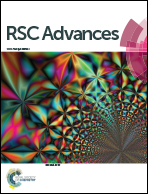A UV-driven superhydrophilic/superoleophobic polyelectrolyte multilayer film on fabric and its application in oil/water separation
Abstract
Superhydrophilic/superoleophobic materials have more obvious advantages in anti-pollution and oil/water separation, but the preparation is very challenging due to the higher surface tension of water than that of oils. Reported herein is a new superhydrophilic/superoleophobic surface that is prepared through UV irradiation of a polyelectrolyte multilayer film (PMF) with perfluorooctanoate (PFO) as the counterions on a commercially available cotton fabric. Hydrophilic defect domains along with PFO counterions on the PMF-coated fabric result in simultaneous superhydrophilicity and superoleophobicity both in air and underwater. Water can pass through the fabric by the driving force of gravity, while oils remain above the fabric without any pollution and permeation. The peculiar wetting behavior of the fabric is useful for the gravity-driven oil/water separation with excellent anti-fouling capacity and high efficiency. The recyclability and stability of the superhydrophilic/superoleophobic PMF-coated fabric were also investigated. We anticipate that this novel method could promote the application of superhydrophilic/superoleophobic materials in the field of oil/water separation.


 Please wait while we load your content...
Please wait while we load your content...